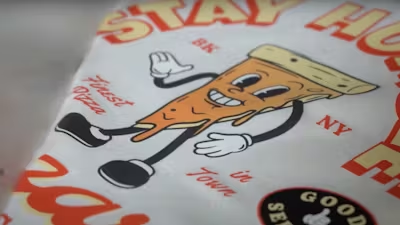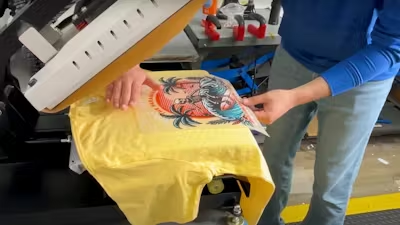With the rise of Direct-To-Film (DTF) transfers, much attention is given to the exciting processes of creation and application. However, an often-overlooked aspect is the storage of these transfers, which can make the difference between a vibrant, durable design and a lackluster, unusable one.
One of the biggest advantages of DTF transfers is their flexibility—they can be pressed onto garments as needed. This convenience leads to a common question: "How should I store DTF transfers to ensure they remain in top condition?" The answer involves understanding the interplay of the key components: the ink, PET film, and the hot melt powder adhesive.
In this guide, we’ll dive into the essentials of DTF transfer storage. We’ll discuss the optimal storage duration, potential pitfalls, and expert tips to keep your transfers ready for action whenever you need them. Let's get started!

How long can DTF transfers be stored?
Although long-term storage is possible, we generally recommend using them within 3 to 12 months for optimal results. If you're unable to maintain proper storage conditions, plan to press your DTF transfers within 30 days to avoid any degradation in quality.
There's no one-size-fits-all answer to this question–it hinges largely on storage conditions. However, your DTF transfers can last years in a cool, dry, and sunlight-free environment. If you're new to the direct-to-film world, start with our introduction to the technique: What is a DTF transfer?
Risk factors of DTF storage
DTF transfers face dangers from four primary adversaries: extreme temperature, moisture, sunlight and dust. Here's why why these elements pose a risk.

- Temperature - DTF transfers do best at room temperature or slightly below. Like a zen warrior, seek balance. Extreme temperatures disrupt the harmony of stored transfers. Particularly, heat can melt the adhesive. A single hot summer day sitting in a warehouse can cause transfers to stick together.
- Moisture - The primary arch-nemesis of DTF transfers is moisture in the air, so a climate-controlled environment is key. High humidity levels above 50% can adversely impact your transfers. Telltale signs of moisture damage include print bubbles or edges starting to peel up.
- Sunlight - Although direct sunlight should have little effect on the vibrancy of the printed transfer, the sun rays can activate the glue. Even if your overall room temperature is stable, sunbeams hitting the surface for prolonged times can cause concentrated heat.
- Dust - Airborne particles can collect and stick to your DTF transfers over time, reducing their adhesive power upon pressing. Maintaining a dust-free storage environment is crucial to preserving their quality.

DTF storage basics
Storing your DTF transfers properly is simple if you know the basics. Here are the four keys long-term storage. Use these techniques to ensure your transfers are ready for action when you need them:
- Use airtight containers. Ziplock bags, bins, plastic folders. Anything airtight.
- Lay them flat. Avoid storing at an angle, off of an edge, or bent in any way.
- Don't over-stack. Avoid tall piles or any additional weight on top of transfers.
- Interleaving. Use sheets of paper to alternate between transfers in a stack.
DTF storage essentials
To ensure success for long-term storage of your transfers, you need the following essentials. These items are affordable, easily found online, and can purchased in bulk.

Resealable Bags
Ziplock bags easily create a sealed environment, free from external contaminants. They are not only versatile, given their availability in various sizes, but they also offer a cost-effective way to store multiple transfers safely. The key is to expel as much air as possible before sealing. Trapped air can lead to moisture buildup.
Silica Packets
These small packets are filled with silica gel, a desiccant that soaks up unwanted moisture like a sponge. Placing a packet inside your storage bag or container adds an extra line of defense against humidity. This is especially crucial for shipping, and ensures your transfers remain unaffected by weather changes during their journey.
Parchment Paper
By placing a sheet between each transfer (especially if you're storing them for longer than a month) you ensure that each transfer remains separate and free from any adhesive interaction with its neighbors. It's a small step that goes a long way in maintaining the quality and integrity of each transfer.
Plastic Airtight Containers
Available in an array of sizes and designs that cater to various storage needs, from small batches to larger stockpiles. By investing in a quality container, you're ensuring that your transfers remain in pristine condition, regardless for how long. Sturdy containers ensure your transfers are not just stored; they're protected.

Pro tips for storing DTF transfers
Embarking on your journey as a Transfer Ninja involves more than knowing the basics. Whether you're a small business owner pressing transfers on-demand or an organization reprinting uniforms and branding different items as you go, these pro tips will guide you and give you the edge. The keys here are accessibility and minimal contact. The less your transfers are handled, the better they retain their quality.
- Gang sheets - If you've acquired rolls of gang sheets, you can keep them stored as-is to be cut when needed, as long as the rolls are stored in an airtight bag. Many different-sized cylindrical bags are available from major companies online, and twist-tie can be used to seal. There are different strategies for pre-cut transfers, depending on your business' turnover rate, detailed below.
- Shelving and organizers - Use shelving solutions from office supply stores to keep your DTF transfers organized and accessible. Look for shelving meant for storing letter-size papers or larger ones. This works well for high-turnover businesses where DTF transfers are used regularly.
- File folder system - An old-school flat file is ideal (and hard to come by these days). A filing cabinet with drawers and labeled file folders can help organize your transfers (although it may not be suitable for larger transfers). Each customer or item type can have its own folder, making locating the transfers you need easy.
- Storing large quantities - Stacking too many on top of each other can cause the bottom transfers to stick together, resulting in ruined transfers. Even if using the interleaving technique, store them in stacks of 50-100 or less to reduce this risk.
- Climate control - Using automatic temperature control and dehumidifiers ensures the environment is perfect for your transfers. If you don't have central air, small dehumidifier machines can help if placed near the stored transfers (and emptied regularly) but opt for larger professional models if possible.
- Troubleshooting - If your transfers don't stick after proper pressing, you have trouble with the peeling process, or the film is wrinkled or warped, that's usually a sign they're past their prime. It might be time to order fresh transfers from Ninja Transfers.

Conclusion
The art of DTF transfers isn't just in the pressing but also in the storing. Properly stored DTF transfers lead to vibrant, lasting prints that impress even the most discerning customers. Remember, the four enemies to guard against are sunlight, extreme temperatures, and moisture. Use our recommended storage methods to create an ideal environment for your transfers.
But even the best-stored DTF transfers won't last forever. So make sure to press them within the recommended time frame while keeping suitable stock levels on hand, and reorder from Ninja Transfers as needed. Our high-quality DTF transfers help ensure that every press you make succeeds.
We hope our guide to storing DTF transfers serves you well on your path to becoming a master of the heat transfer arts.








































